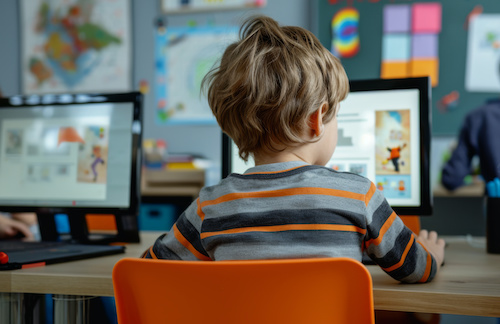Key points:
Educational technology transforms learning by increasing engagement, personalizing instruction, and expanding access to resources. It facilitates interactive and dynamic teaching methods, supports diverse learning needs, and prepares students for a technology-driven world, making education more effective and relevant. Why is educational technology important in the classroom? Read on to discover why.
Why is educational technology important in teaching and learning?
Educational technology is important in the classroom because it fundamentally enhances teaching and learning processes, making education more engaging, personalized, and effective. Increased engagement is one of the primary benefits and highlights the importance of technology in the classroom. Interactive tools such as multimedia presentations, educational apps, and virtual simulations capture students’ attention and make learning more stimulating. This engagement helps maintain students’ interest and improves their understanding of complex concepts.
Personalized learning is another critical advantage. Technology enables educators to tailor instruction to meet the diverse needs of students. Adaptive learning platforms can adjust content based on individual performance, allowing students to progress at their own pace. This personalized approach ensures that all learners, regardless of their abilities, receive the appropriate support and challenge.
Access to resources is significantly broadened through technology. Students can explore a vast array of online materials, from digital textbooks to research databases and interactive tutorials. This access supports independent learning and encourages students to engage with a wider range of information.
Additionally, technology fosters collaboration. Digital tools like Google Classroom and shared platforms enable students to work together on projects, enhancing their teamwork and communication skills.
Overall, educational technology enriches the classroom experience, making learning more dynamic, tailored, and accessible while preparing students for a technology-driven future.
How important is technology in education?
The importance of educational technology for the teacher and student cannot be understated– it reshapes traditional teaching and learning methods, offering numerous benefits that enhance educational outcomes. Engagement is one of the key areas where technology makes a significant impact. Interactive tools such as digital simulations, multimedia presentations, and educational apps capture students’ attention and make learning more engaging. This increased engagement often leads to improved understanding and retention of information.
Personalized learning is another crucial benefit of technology. Adaptive learning platforms allow educators to tailor instruction to meet individual student needs. These systems can adjust content difficulty based on student performance, providing a customized learning experience that supports diverse abilities and learning styles. This personalization helps ensure that each student receives the appropriate level of challenge and support.
Access to information is greatly expanded through technology. Students have the ability to access a vast range of online resources, including research databases, digital textbooks, and interactive tutorials. This broad access supports independent learning and encourages deeper exploration of subjects.
Furthermore, technology promotes collaboration by enabling students to work together on projects and share ideas through digital platforms. These collaborative tools help develop teamwork and communication skills, essential for future success.
Technology is vital in education for enhancing engagement, personalizing learning, expanding access to resources, and fostering collaboration, ultimately preparing students for a technology-driven world.
How can learners benefit most in the use of technology?
The use of technology in the classroom to enhance teaching and learning offers many benefits. Learners can gain substantial benefits from technology when it is used strategically to enhance engagement, personalize learning, and foster collaboration. Enhanced engagement is one of the key advantages. Interactive tools such as educational apps, multimedia content, and virtual simulations make lessons more engaging and stimulating. These resources help capture students’ attention and make complex concepts more accessible, leading to improved understanding and retention.
Personalized learning is another critical benefit. Technology allows for the use of adaptive learning platforms that adjust educational content based on individual performance. This means students can learn at their own pace, receiving additional support if needed or advancing more quickly if they grasp concepts easily. Such tailored instruction ensures that all learners receive appropriate challenges and support, catering to their unique needs.
Collaboration is also enhanced through technology. Digital tools like Google Classroom, shared documents, and discussion boards enable students to work together on projects and assignments, regardless of their location. This fosters teamwork, communication, and problem-solving skills, which are essential for academic and professional success.
Additionally, technology provides access to a wide range of resources. Students can explore online libraries, research databases, and educational websites, facilitating independent learning and allowing for deeper exploration of subjects.
What are 5 advantages of technology in education?
When it comes to the benefits of technology in the classroom, edtech offers several advantages in education, significantly enhancing both teaching and learning. First, it increases engagement through interactive tools such as multimedia presentations and educational apps, which capture students’ attention and make learning more dynamic. Second, technology personalizes learning by allowing adaptive learning platforms to tailor content to individual student needs, ensuring that each learner progresses at their own pace.
Third, technology expands access to resources. Students can utilize online libraries, digital textbooks, and educational websites to explore a wide range of information beyond traditional textbooks. Fourth, it enhances collaboration through tools like Google Classroom and shared documents, enabling students to work together on projects and communicate effectively.
Finally, technology improves efficiency in the classroom by automating administrative tasks such as grading and record-keeping, allowing teachers to focus more on instruction and personalized support. These advantages collectively transform the educational experience, making it more engaging, accessible, and effective.
Conclusion
Educational technology is vital in the classroom as it enhances engagement, supports personalized learning, and broadens access to resources. By integrating technology, educators can create a more interactive, inclusive, and efficient learning environment, better preparing students for future academic and professional challenges in a digital world.


